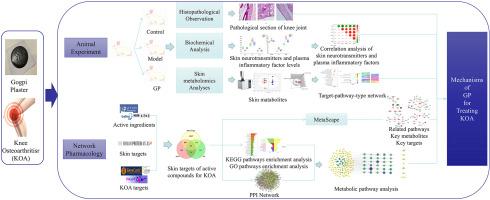Integrated skin metabolomics and network pharmacology to explore the mechanisms of Goupi Plaster for treating knee osteoarthritis
IF 3
3区 医学
Q1 INTEGRATIVE & COMPLEMENTARY MEDICINE
Journal of Traditional and Complementary Medicine
Pub Date : 2024-04-12
DOI:10.1016/j.jtcme.2024.04.004
引用次数: 0
Abstract
Background and aim
Goupi Plaster (GP) is topical traditional Chinese medicine preparation. It has been used to treat Knee Osteoarthritis (KOA) in clinical practice of traditional Chinese medicine (TCM). However, the mechanisms of GP relieve KOA are poorly understood.
Experimental procedure
Rabbit models of KOA were established and treated with GP. Knee cartilage pathology was analyzed using hematoxylin and eosin staining, while plasma levels of inflammatory factors (interleukin (IL)-4, IL-6, and IL-17) and skin neurotransmitters (calcitonin gene-related peptide (CGRP), substance P (SP), and5-hydroxytryptamine (5-HT)) were measured by enzyme linked immunosorbent assay. Metabolomics based on GC-TOF-MS analysis screened for skin biomarkers as well as relevant pathways. Network pharmacology screened for relevant skin targets as well as relevant pathways, and finally, MetScape software was utilized to integrate the results of metabolomics and network pharmacology to screen for key skin targets, key metabolites, and key pathways for GP treatment of KOA.
Results and conclusion
GP administration substantially repaired cartilage surface breaks in KOA and led to relatively intact cartilage structure and normal cell morphology. GP decreased plasma levels of IL-6 and IL-17 and skin levels of CGRP, SP and 5-HT while increased plasma IL-4. GP administration normalized the levels of 15 metabolites which were changed in KOA. Network pharmacology analysis identified 181 targets. Finally, 3 key targets, 5 key metabolites and 3 related pathways were identified, which suggested that GP improved skin barrier function and skin permeability by regulating skin lipid metabolism. GP treatment also regulated skin amino acid levels and subsequently affected neurotransmitters and signaling molecules. In addition, the purinergic signaling pathway was also involved in the treatment of GP against KOA.
In conclusion, GP treatment is associated with changes in skin lipid metabolism, neurotransmitters, and the purinergic signaling pathway.

整合皮肤代谢组学和网络药理学,探索狗皮膏药治疗膝骨关节炎的机制
背景和目的狗皮膏药(GP)是一种外用传统中药制剂。在中医临床实践中,它一直被用于治疗膝关节骨性关节炎(KOA)。实验过程建立 KOA 兔子模型,并使用 GP 治疗。用苏木精和伊红染色法分析膝关节软骨病理,用酶联免疫吸附法测定血浆中炎症因子(白细胞介素(IL)-4、IL-6 和 IL-17)和皮肤神经递质(降钙素基因相关肽(CGRP)、P 物质(SP)和 5-羟色胺(5-HT))的水平。基于 GC-TOF-MS 分析的代谢组学筛选了皮肤生物标记物和相关途径。最后,利用 MetScape 软件整合代谢组学和网络药理学的结果,筛选出 GP 治疗 KOA 的关键皮肤靶点、关键代谢物和关键通路。GP 降低了血浆中 IL-6 和 IL-17 的水平以及皮肤中 CGRP、SP 和 5-HT 的水平,同时提高了血浆中 IL-4 的水平。GP能使KOA中发生变化的15种代谢物水平恢复正常。网络药理学分析确定了 181 个靶点。最后,确定了 3 个关键靶点、5 个关键代谢物和 3 条相关通路,这表明 GP 可通过调节皮肤脂质代谢改善皮肤屏障功能和皮肤通透性。GP 治疗还能调节皮肤氨基酸水平,进而影响神经递质和信号分子。总之,GP 治疗与皮肤脂质代谢、神经递质和嘌呤能信号通路的变化有关。
本文章由计算机程序翻译,如有差异,请以英文原文为准。
求助全文
约1分钟内获得全文
求助全文
来源期刊

Journal of Traditional and Complementary Medicine
Medicine-Complementary and Alternative Medicine
CiteScore
9.30
自引率
6.70%
发文量
78
审稿时长
66 days
期刊介绍:
eJTCM is committed to publish research providing the biological and clinical grounds for using Traditional and Complementary Medical treatments as well as studies that demonstrate the pathophysiological and molecular/biochemical bases supporting the effectiveness of such treatments. Review articles are by invitation only.
eJTCM is receiving an increasing amount of submission, and we need to adopt more stringent criteria to select the articles that can be considered for peer review. Note that eJTCM is striving to increase the quality and medical relevance of the publications.
 求助内容:
求助内容: 应助结果提醒方式:
应助结果提醒方式:


